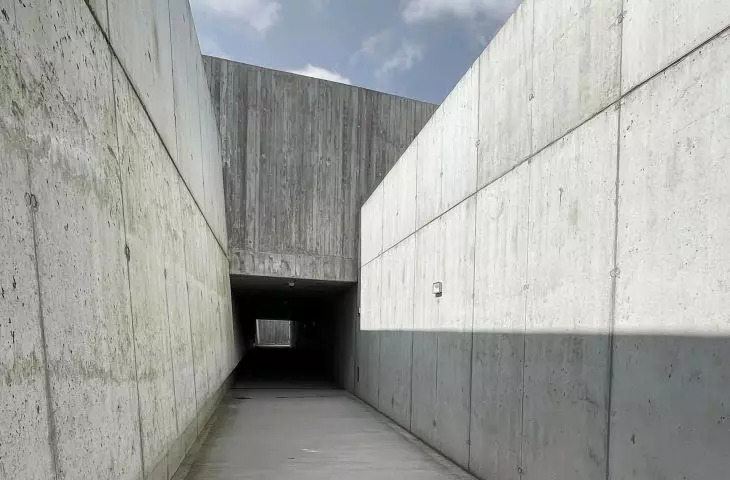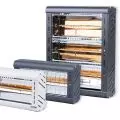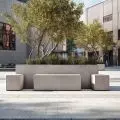There are projects that touch on the most painful subjects. How to encapsulate the piercing silence in a solid? Can architecture prepare for the difficult experience we are about to face? How much sensitivity does such a task require from an architect?
More than 1.67 million people visited the Auschwitz-Birkenau Memorial last year. Since recently, the organization of the visitor path has been supported by a Visitor Service Center (COO) linked to the museum grounds, designed by Kozień Architekci, a Krakow-based studio.
site development plan
© Kozien Architekci
Visitors enter the museum site from the parking area through the gate of the information and ticket office building to reach the waiting area, which is located in the former slaughterhouse building - a relic of the past that has been restored to its wartime character. This is also where the descent to the underground begins, by which, passing through the area of the symbolic Memorial Square paved with granite stone from the demolition of the former road leading to the slaughterhouse, visitors enter the museum area through the former freezing and cooling halls. The underground passageways are separated into entrance and exit routes. A three-story hostel for Memorial volunteers has also been built adjacent to the COO.
plan of level -1
© Kozień Architekci
The center's design is the result of a competition decided in 2010. At the time, the jury chaired by Krzysztof Chwalibog of the Warsaw branch of SARP recognized the proposal of the Krakow team thanks to its concise and expressive concept, as well as the creation of a backdrop to create a mood of concentration.
However, a lot of time has passed since 2010, although the construction project was conceived three years later, the first stage of construction was completed only last year. Would the architects do things differently today? As Magdalena Kozien-Wozniak assures, work on the project continued continuously until the start of construction and consisted mainly of functional, technical and technological corrections, but both the idea and form of the project were not changed.
Visitor Service Center of the Auschwitz-Birkenau State Museum in Oświęcim
© Kozień Architekci
zone of silence
The Auschwitz-Birkenau camp is a monument, a place-sign. Zone of Silence. The spatial composition of the service area and the entrance to the site should listen to this silence. In silence," the designers explain.
staircase detail
© Kozien Architekci
The center is thus meant to provide a certain buffer between the piercing noise of everyday life and the aforementioned silence, which the museum allows to resound. What were the challenges of implementing the project in such a difficult context?
This place taught us, above all, to respect the authentic substance. We did not realize how difficult the task would be to rebuild the devastated building of the former slaughterhouse, which over the years has been repeatedly rebuilt for various functions, so that it has lost its original character," explains Magdalena Kozień-Woźniak. - The object was intended to be the central element of the designed spatial-functional layout. We have succeeded in realizing this assumption: the concrete bunker, the reinforced concrete pillars of the hall of the former slaughterhouse, freezer and cold storage, the ceilings in the waiting room and toilets are important witnesses of the past," the architect adds.
Visitor Service Center at the Auschwitz-Birkenau State Museum in Oswiecim; Memorial Square paved with granite stone from the demolition of the former road leading to the slaughterhouse
© Kozien Architekci
the chill of concrete
The Visitor Service Center at the Auschwitz-Birkenau State Museum in Oswiecim welcomes visitors with the coolness of austere concrete walls. Why did the architects decide on this particular material?
interior of the former slaughterhouse
© Kozien Architekci
We noticed that concrete is an important material in the reconstructed building of the former slaughterhouse," answers Magdalena Kozień-Wozniak. - Original historical elements, such as the ceiling of the waiting room and the old concrete bunker, were supplemented with new elements: column reinforcements, lintels, basement exit walls. Underground passageways were constructed using reinforced concrete diaphragm walls, which was an obvious choice. They perform the function of external walls and at the same time provide protection for the excavation. This solution minimized the extent of earthworks associated with the construction of tunnels and uncovered exit ramps. The monolithic reinforced concrete structure of the hostel building and the prefabricated facade panels were just a consistent complement to the whole, he adds.
The ceiling of the waiting room, the interior of the former slaughterhouse
© Kozien Architekci
beginning and end
The project won this year's SARP Award in the "Architecture in Heritage Space" category. The jury appreciated the building for its consistently implemented and visible in the smallest details idea of building a message-message, which is created in the process of entering the former camp.
The center is the first and last thing visitors to this special place will see - it is here that a visit to the museum begins and ends. An expedition that will probably be decided on only once.
Concrete, which was an important material in the reconstructed building of the former slaughterhouse, is also found in other parts of the center
© Kozien Architects






































































